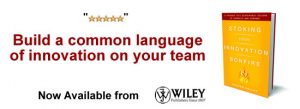Unlock Your Inner Edison

Time’s recent cover story on Thomas Edison, America’s greatest inventor, makes both instructive and inspirational reading.
Aside from patenting over 1,000 ideas in his lifetime, Edison gave birth to the modern ideas-driven organization. As the Time article points out, his Menlo Park “invention factory†was “the forerunner of every business-world creative cockpit, from the Ford engineering center to the Microsoft campus and Google’s Googleplex.â€
I’ve always admired Edison’s seemingly endless capacity for innovation. But, after reading the article, I am even more in awe of how focused and productive he was. The Menlo Park laboratory, Edison famously claimed, would produce a minor invention every 10 days, and a major breakthrough every six months.
As if that weren’t enough, Edison’s invention to-do list was ambitious to say the least. It included, among other things, a long-distance telephone transmitter, an electric piano, a new version of the phonograph, and ink for the blind!
Edison is one of the greatest exemplars of the term “purpose-inspired, benefit-driven.†He very deliberately – not casually, not tangentially – sought to make the world a better place. He was an interventionist, a provocateur, a radical optimist.
Edison’s commitment to goal-setting can be directed at more than the future of the world. As I’ve written here before, I have found great success in creating 100 Day Plans. These short-term to-do lists keep me focused on the big picture and prevent me from getting consumed by the urgent at the expense of the important.
How many times have you spent an entire day dealing with immediate problems – sorting through email, going to meetings, straightening up your desk – without devoting any time to your broader goals? The 100 Day Plan is a simple antidote to this problem that only requires a pen and paper.
My 100 Day Plans always consist of about 10 items, each of which starts with a verb and contains no more than three words. This ensures that goals are simple and well-defined. What might be on the President’s 100 Day Plan: Fix Gulf oil. Stimulate jobs. Solve Iraq/Afghanistan. Solve Social Security.
Don’t underestimate the power of this technique. Many of the ideas that Edison wrote down in his notebook are now realities. And it all started with a simple to-do list.
Thomas Edison’s to do list, image source: The Thomas Edison Papers at Rutgers
Wait! Before you go…
Choose how you want the latest innovation content delivered to you:
- Daily — RSS Feed — Email — Twitter — Facebook — Linkedin Today
- Weekly — Email Newsletter — Free Magazine — Linkedin Group
 Kevin Roberts is the CEO worldwide of The Lovemarks Company, Saatchi & Saatchi. For more information on Kevin, please go to www.saatchikevin.com. To see this blog at its original source, please go to www.krconnect.blogspot.com.
Kevin Roberts is the CEO worldwide of The Lovemarks Company, Saatchi & Saatchi. For more information on Kevin, please go to www.saatchikevin.com. To see this blog at its original source, please go to www.krconnect.blogspot.com.
NEVER MISS ANOTHER NEWSLETTER!
LATEST BLOGS
The Evil Downside of Gift Cards
This past holiday season I saw probably one too many articles trumpeting the value of gift cards to retailers and how they are a great thing for retailers. My skeptic side starts coming out as I see article after article appear, and I have to start asking “Is the increasing prevalence of gift cards as a holiday gift (primarily Christmas) a good thing for retailers?”
Read MoreWhy the iPhone will not succeed – Yet
The new Apple iPhone is set to launch on June 29, 2007 and the press and investors are making it a darling. Investors have run Apple’s stock price up from about $85 per share before its announcement to $125 per share recently, but the iPhone still will not succeed – at least not yet.
Read More





A to do list is a great idea. Re: Edison however, does one of his to do lists say ‘Get Nikola Tesla to solve the problem’ and then ‘Stiff him on the bill’?
Your comments about Edison being “purpose-inspired, benefit-driven” are accurate. Because Edison focused on needs first versus his own raw ideas, he was able to work productively and deliver tremendous “utility,” as he would say. I also enjoyed the TIME cover story on Edison, although I felt it reflected a more academic, fact-based focus than delivering “how to” insights for today’s business leaders. Thanks for your acknowledgement of the TAE Papers at Rutgers….a priceless treasure.
Phil, That was great! I’m sure he had it written down somewhere. Both men were great, and both men had a lot to teach us, even today. Too bad much of the work Tesla created remains missing.
Great commentary. Edison was gifted with a unique combination of vision, unique perspectives, innovative problem solving, tenacity and accountability. One of my favorite Edsion quotes:
“We now know a thousand ways not to build a light bulbâ€
Thanks for the guidelines you have provided here. Yet another thing I would like to talk about is that laptop memory needs generally rise along with other advancements in the engineering. For instance, when new generations of processor chips are introduced to the market, there’s usually a matching increase in the shape demands of all pc memory plus hard drive room. This is because software program operated simply by these processor chips will inevitably surge in power to use the new technological know-how.
Yes we were having “site memory problems” last night. But they should be fixed now! Please persist, and thanks for contributing.